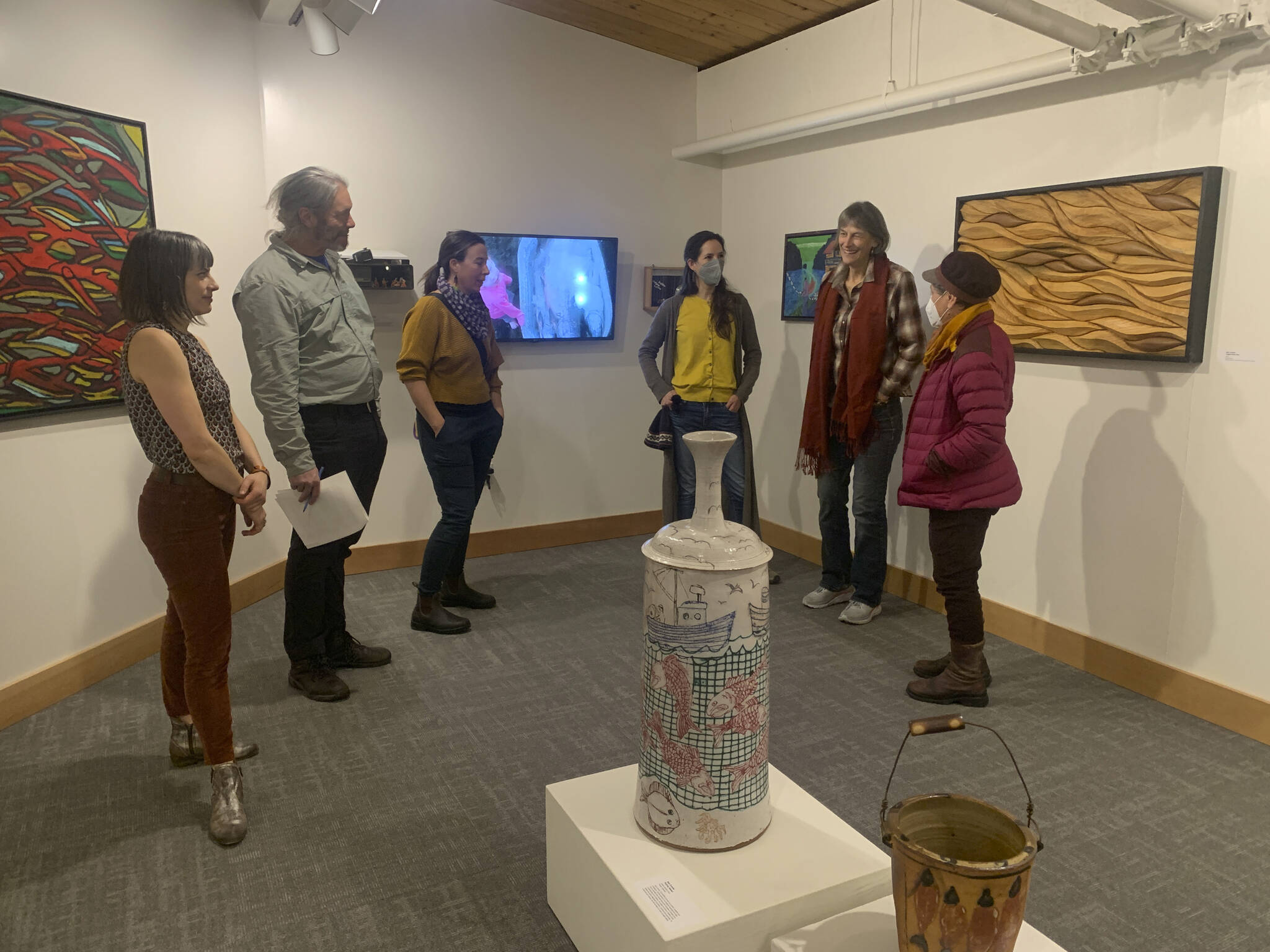Organized by a circle of Alaska Native salmon people, the Pratt Museum’s exhibit, Salmon Culture, honors salmon as a resource that has for thousands of years provided physical and spiritual nourishment to communities around the state.
“Salmon are gifts, every single one is a blessing,” said exhibit advisory circle member Erin Gingrich. “The continuity of their ancient cycle is something we owe to the past, present, and future, not just our own future generations, but the futures of all that have a part in this ecosystem.”
Salmon Culture opened to the public in October, celebrating the connection between salmon and Alaska Native peoples through works of art by 35 Alaska Native artists from numerous communities — Aleknagik, Anchorage, Beaver, Juneau, Kasilof, Kenai, Kodiak, Nanwalek, Sitka and Sutton, as well as Seattle.
Artwork from private collections is also included, as well as from the museum collections. Fish skin masks, wooden masks, fish skin baskets, paintings, carvings, glasswork, prints, sculptures, jewelry, a fish skin parka, and archaeological materials are just a few of the items on display.
In the nearby community gallery is the sister exhibit, Salmon Culture: Kachemak Bay Connections. This exhibit also celebrates salmon, but with a more local focus. It showcases 19 works of art by 12 artists, including Seldovia artist Valisa Higman, Halibut Cove artist Marian Beck, the late Ron Senungetuk and Alex Combs, as well as Homer artists Rika Mouw, Oceana Wills, Catie Bursch, Deb Lowney, Lisa Wood, Mike Sirl, Miranda Weiss and Carla Klinker Cope. Featured are paintings, jewelry, moving pictures, written word, ceramics, carved wood, mixed media and more. Work is from the artists themselves, as well as from private collections and the museum’s collections.
Curated by daughters of salmon fishermen, artist Carla Klinker Cope and art historian Nadia Jackinsky-Sethi, the women grew up together in Homer and share a love for art, respect for salmon, and passion for stewardship.
“Here in Homer, we are all connected by salmon in some way,” Jackinsky-Sethi said. “There’s a seasonal rhythm of participating in getting salmon — fishing at the Fishing Hole, on Kachemak Bay or across the Bay, subsistence fishing on the Spit, fishing Bristol Bay for the summer, supporting local fishermen, filling your freezer, sharing with your neighbor. However you’re participating, salmon unite us.”
Celebrating these local connections with salmon, the two also wanted to inspire new ways that individuals might imagine or re-imagine their relationship to the fish.
“We want people to look at this exhibit and ask themselves why they should protect this resource that cares for us,” Cope said. “Whether that’s eating salmon, making our livelihood fishing for them, viewing them spawning, painting them.”
Their exhibit also includes pieces from the museum’s and private collections. One example is items from Halibut Cove resident Dave Beck’s archaeological collection that includes sewing needles, gut scrapers and fishhooks.
“People have been fishing here for such a long time and to hold an ulu that is four thousand years old is pretty incredible,” Jackinsky-Sethi said.
In addition to a display of history, beauty, and reverence, both exhibits address environmental and political issues.
Rochelle Adams, an Athabascan artist from the village of Beaver created a beaded, leather and salmon skin necklace that is on display in the main gallery.
“As people of these lands, whose ancestors are these lands and are these waters, it is our obligation to continue this stewardship,” she said. “The Yukon River salmon need our stewardship and love to help bring the balance back to the River, their home. We need to advocate for their lives. … The Salmon have always provided for us. Now it is time for us to provide and stand up for them.”
In the community gallery, Hanging by a Thread is a wall piece by Homer artist Rika Mouw, made from salmon vertebrae, spruce, thread and gold leaf.
“Individual wealth continues to be amassed at the expense of home, community, land and sustenance … and now wild salmon are becoming an endangered species in Alaska too,” Mouw said. “As an artist and chronicler, I use salmon vertebrae to express the awe and celebration of their complex lives … and as a dire warning.”
Cope and Jackinsky-Sethi said that they consider this exhibit a first run and that they can envision adding to and creating a much larger archive.
“We have such an incredible artistic history in Homer with so many working artists and because of timing and space, we couldn’t include everyone we would have liked to,” Cope said. “This is just like the first run of fish up the river. What you see in this exhibit are artists that we know about and artwork that we both love. This room is very much about our own personal connections to people and place, with salmon bringing us together.”
Creating a space that celebrates the living traditions of how salmon shape and unite the lives of locals, Cope and Jackinsky-Sethi invite everyone to stop by the museum and browse the exhibits.
“What I see binding the work in both galleries is an abiding love and respect for the land and this incredible abundance that we are privileged to take part in,” Cope shared.
Salmon Culture and Salmon Culture: Kachemak Bay Connections are on display at the Pratt Museum through mid-December.


